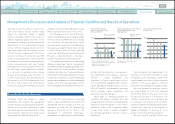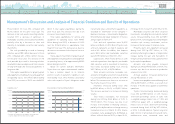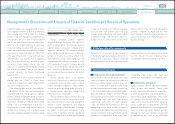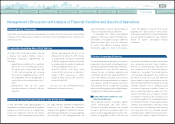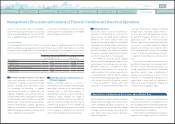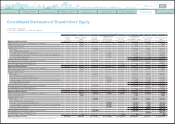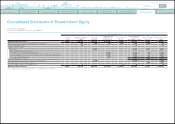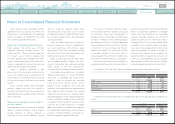Toyota 2012 Annual Report Download - page 75
Download and view the complete annual report
Please find page 75 of the 2012 Toyota annual report below. You can navigate through the pages in the report by either clicking on the pages listed below, or by using the keyword search tool below to find specific information within the annual report.
TOYOTA ANNUAL REPORT 2012
Toyota Global Vision Changes for Making
Ever-Better Cars President
ʼ
s Message Medium- to Long-Term
Growth Initiatives Special Feature Management and
Corporate Information Investor Information
Business and
Performance Review Financial Section
Management's Discussion and Analysis of Financial Condition and Results of Operations
assets of 3.9% are the results of assumptions
used for the various pension plans in calculating
Toyota
ʼ
s consolidated pension costs for fiscal 2012.
Also, a weighted-average discount rate of 2.6%
is the result of assumption used for the various
pension plans in calculating Toyota
ʼ
s consolidated
pension obligations for fiscal 2012.
The following table illustrates the effects of assumed changes in weighted-average discount rates
and the weighted-average expected rate of return on plan assets, which Toyota believes are critical
estimates in determining pension costs and obligations, assuming all other assumptions are consistent.
Sensitivity analysis
Yen in millions
Effect on pre-tax income for
the year ended March 31, 2013
Effect on PBO
as of March 31, 2012
Discount rates
0.5% decrease ¥
(
10,019
)
¥ 203,889
0.5% increase 9,625
(
178,641
)
Expected rate of return on plan assets
0.5% decrease ¥
(
6,354
)
0.5% increase 6,354
Toyota uses derivatives in the normal course
of business to manage its exposure to foreign
currency exchange rates and interest rates.
The accounting for derivatives is complex
and continues to evolve. In addition, there are
significant judgments and estimates involved,
using information from counterparties or market,
in estimating fair value in the absence of quoted
market values. These estimates are based upon
valuation methodologies deemed appropriate
under the circumstances. However, the use of
different assumptions may have a material effect
on the estimated fair value amounts.
The factors used to assess the likelihood of
realization of the deferred tax assets are the
future reversal of existing taxable temporary
differences, the future taxable income and
available tax planning strategies that are prudent
and feasible. All available evidence, both positive
and negative, is considered to determine whether,
based on the weight of that evidence, a valuation
allowance is needed for deferred tax assets which
are not more-likely-than-not to be realized.
As of March 31, 2012, the parent company
and its national tax filing group in Japan are in a
cumulative pre-tax loss position in recent years.
Meanwhile, Toyota has concluded that there
is sufficient positive evidence to overcome the
negative evidence of this cumulative pre-tax loss
as operating results from the parent company
and its national tax filing group in Japan recovered
in the second half of this fiscal year as a results
of increased production volume, vehicle unit
sales and cost reduction from the first half of the
fiscal year. Other positive evidence considered
includes future forecasted taxable income in
the fiscal year 2013 and beyond and effective
tax planning strategies, inclusive of sales of
appreciated assets. This forecasted taxable
income is expected to be generated mainly from
an increase in worldwide automotive industry
demand and continuous cost reduction efforts
and is anticipated to be sufficient, over a number
of years, to realize the deferred tax assets prior
to expiration of operating loss carryforwards in
2021.
If the sufficient taxable income for the fiscal
year 2013 or future years is not achieved due to
the factors which cannot be anticipated such
as high competition and volatility of worldwide
automotive market, steep strengthening of
Japanese yen and increase in prices for raw
materials, or if tax planning strategies are no
longer viable, it could affect the realization of
deferred tax assets of the parent company and
its national tax filing group in Japan.
■
Derivatives and Other Contracts at Fair Value
■
Deferred Tax Assets
Toyota
ʼ
s accounting policy is to record a
write-down of such investments to net realizable
value when a decline in fair value below the
carrying value is other-than-temporary. In
determining if a decline in value is other-than-
temporary, Toyota considers the length of
time and the extent to which the fair value has
been less than the carrying value, the financial
condition and prospects of the company and
Toyota
ʼ
s ability and intent to retain its investment
in the company for a period of time sufficient to
allow for any anticipated recovery in fair value.
■
Marketable Securities and Investments in
Affiliated Companies
Toyota is exposed to market risk from changes in
foreign currency exchange rates, interest rates,
certain commodity and equity security prices. In
order to manage the risk arising from changes
in foreign currency exchange rates and interest
rates, Toyota enters into a variety of derivative
financial instruments.
A description of Toyota
ʼ
s accounting policies
for derivative instruments is included in note 2 to
the consolidated financial statements and further
disclosure is provided in notes 20 and 21 to the
consolidated financial statements.
Toyota monitors and manages these financial
exposures as an integral part of its overall risk
Quantitative and Qualitative Disclosures about Market Risk
0820
Search NextPrev page 75
Contents





